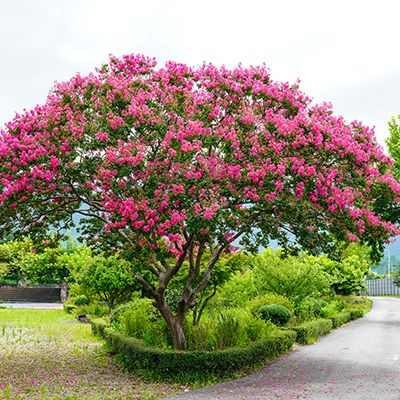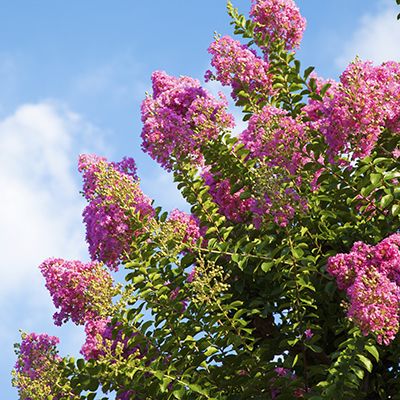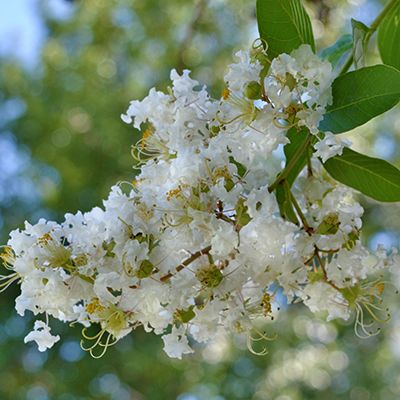


Crape Myrtle
Crape Myrtle (Lagerstroemia sp.) are native to China, Japan and Korea. More than 200 cultivars exist and more are continually being developed. Currently, at maturity, they range in height from 18 inches to 40 feet. The crown will be up to 75% of the height. Most trees are “lollipop” shaped although a few are columnar. They have showy summer flowers, good looking bark and brilliant fall color.
Crape Myrtles are handsome and very beautiful specimen shrubs or trees; often used in groups. Some of the smaller types are used as hedges, screens or masses. Flower colors range from white pink, orchid, and lavender to dark red.
Crape Myrtles prefer full sun and hot summers. Susceptible varieties will mildew in many areas of the Peninsula. They need a moist, well-drained soil. Our heavy clay soils can be amended with a one-third mixture of compost such as Master Nursery® Gold Rush to produce the well-drained soil. When planting your new tree, make a hole at least twice as wide as the diameter of the plant’s container. Mix one-third, by volume, of the compost with the soil removed from the hole. Use the mixture as backfill for the plant and any remaining soil mixture for a berm around the perimeter of the hole. Fill the backfill area around the tree with water until it stops bubbling and then once a week for the first year. In the second and third year, water as described every two weeks. As the tree matures, extend the berm and irrigate at three to four week intervals. Do not place any plants between the trunk and drip line of the tree. Mulch the area. A lawn sprinkler CAN NEVER provide enough water for the tree. After watering, check the root ball for moisture. No fertilizer for three to four weeks and then twice a year about Memorial Day and Labor Day. Use Master Nursery® Formula 49™ for the fertilizer.
Crape Myrtle bloom on new wood and should be pruned in winter or early spring. On larger plants remove basal suckers, twiggy growth, crossing branches and branches growing toward the center of the plant. Gradually remove side branches up to a height of four to five feet. Prune dwarf forms periodically throughout the growing season, thinning out small twiggy growth.
Among the diseases and insects infecting Crape Myrtle are: (1) powdery mildew, (2) black spot, (3) sooty mold, (4) tip blight, (5) leaf spot, (6) cankers and (7) root rot. Insect pests include (8) aphids, (9) ambrosia beetles and (10) scale. Powdery mildew can be avoided by planting trees with native Indian names such as Picos, Osage, or Yuma. These trees were hybridized at the U.S. National Arboretum in Washington D.C. to be resistant to powdery mildew. Infected susceptible plants can be treated by spraying with sulfur (Safer® Brand Garden Fungicide) twice, one week apart. Root rot is caused by improper irrigation. The other diseases are controlled with a Monterey Liqui-Cop® - Master Nursery® Year-Round Spray Oil mixture. Scale is best controlled with horticultural oil. Use Ortho® MAX® Malathion Insect Spray or Monterey Take Down Garden Spray to control other insects.
There are in excess of 200 cultivars of Crape Myrtle. In general, they have been grouped based on size: Dwarf (2’-4’), Semi-dwarf (5’-12’), Intermediate (13’-20’), and Tree type (23’-33’). The following is a short reference to 20 Lagerstroemia hybrid cultivars introduced by the U.S. National Arboretum
|
Dwarf (2'to 4') |
|||
|
Not yet evaluated by the U.S. National Arboretum |
|||
|
Semi-Dwarf (5' to 12') |
|||
|
Cultivar |
Flower color |
Trunk color |
Fall color |
|
Acoma |
Pure White |
Light gray |
Red-purple |
|
Caddo |
Bright Pink |
Light cinnamon brown |
Orange-red |
|
Hopi |
Clear light pink |
Gray-brown |
Orange-red |
|
Pecos |
Clear medium pink |
Dark brown |
Maroon |
|
Tonto |
Fuchia |
Cream to taupe |
Maroon |
|
Zuni |
Medium lavender |
Light brown-gray |
Dark red |
|
Intermediate (13' to 20') |
|||
|
Cultivar |
Flower color |
Trunk color |
Fall color |
|
Apalechee |
Light lavender |
Cinnamon to chestnut brown |
Orange-russet |
|
Comanche |
Dark coral pink |
Light sandalwood |
Purple-red |
|
Lipan |
Medium lavender |
Near white to beige |
Orange-russet |
|
Osage |
Clear light pink |
Chestnut brown |
Red-purple |
|
Sioux |
Dark pink |
Medium gray-brown |
Red-purple |
|
Yuma |
Bicolored lavender |
Light gray |
Yellow-orange |
|
Tree-Type (23'-33') |
|||
|
Cultivar |
Flower color |
Trunk color |
Fall color |
|
Biloxi |
Pale pink |
Dark brown |
Orange-red |
|
Choctaw |
Clear bright pink |
Light to darker cinnamon brown |
Bronze-maroon |
|
Miami |
Dark coral pink |
Dark chestnut brown |
Red-orange |
|
Muskogee |
Light lavender |
Light gray-brown |
Red |
|
Natchez |
White |
Cinnamon brown |
Orange to red |
|
Tuscarora |
Dark coral pink |
Light brown-gray |
Red-orange |
|
Tuskegee |
Dark pink to red |
Light gray-tan |
Orange-red |
|
Wichita |
Light magenta |
Russet brown to mahogany |
Russet to mahogany |